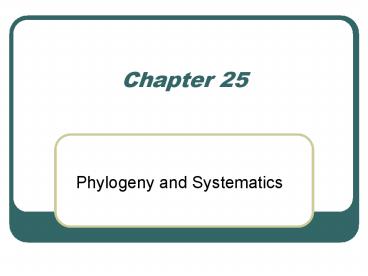Phylogeny and Systematics - PowerPoint PPT Presentation
1 / 22
Title:
Phylogeny and Systematics
Description:
Hardened parts of the organism are replaced with minerals and form ... is closely related to the african lion (Panthera leo) and the Tiger (Panthera tigris) ... – PowerPoint PPT presentation
Number of Views:78
Avg rating:3.0/5.0
Title: Phylogeny and Systematics
1
Chapter 25
- Phylogeny and Systematics
2
Phylogeny
- Evolutionary history of a species or group of
related species - Systematics is the science of constructing
phylogeny
3
Fossils
- Serve as a great tool in determining the ancestry
of species - Fossils are formed by sedimentary rock.
- Hardened parts of the organism are replaced with
minerals and form rock like structures - Fossils are also things like footprints, animal
burrows, feces, pollen, etc.
4
Dating Fossils
- Relative Dating identifying organisms and time
periods based on the types of fossils found - We define each time period and major events that
occurred on the Earth with these different layers
of fossils
5
Geological Time Scale
- History of Earth divided into four eras
- Precambrian Earths origin to 543 mya
- Ends with radiation of most modern animal phyla
(called the Cambrian explosion) - Paleozoic 543 mya to 245 mya
- Ends with mass extinctions of many marine and
terrestrial organisms, radiation of reptiles, and
origins of mammal-like reptiles - Mesozoic 245 mya to 65 mya
- Age of Reptiles, flowering plants appear
- Cenozoic 65 mya to present
- Major radiation of mammals, birds, and
pollinating insects
6
(No Transcript)
7
Absolute Dating
- Age of a fossil is given in years, instead of
before or after (ie before Mesozoic) - Radiometric dating measure of certain
radioactive isotopes in fossils or rocks. - Each organism contains two types of carbon
- Carbon-12 and carbon-14
- When the organism dies it stops accumulating
carbon and carbon-14 breaks down into nitrogen-14 - We can then measure the ratio of carbon-14 to
nitrogen 14 to get the date of the fossil.
8
Absolute Dating
- Carbon dating is used for young fossils
- Uranium dating is used for older fossils
9
Phylogeny and Continental Drift
- History of the Earth helps explain the current
biogeography (where animals are and are not) - Continental drift is the major geographic factor
correlating with the spatial distribution of
organisms - Continents drift around on molten lava
- North America and Europe drift apart about 2 cm
per year
10
Continental Drift
- Causes mountain formation and volcanoes
- Near the end of the Paleozoic era all the land
masses were together - Pangea
- Caused life on land and water to be more
competitive
11
Plate Tectonics
12
Continental Drift
- Pangea then began to break apart during the
Mesozoic era - This isolated populations and increased the
evolutionary arena - Remember that population isolation is one key in
speciation - This explains why we see the same fossils in
Africa as South America
13
(No Transcript)
14
History of Life Mass Extinctions
- Fossil record details long periods of relatively
little change with abrupt changes in species - Due to Environmental Factors
- Biological Factors
- Certain species disappear while others that
survive change rapidly - As one species goes extinct it has a great impact
on other organisms
15
Two Important Mass Extinctions
- Permian mass extinction
- Claimed about 90 of marine species
- 8 out of 27 orders of Permian insects perished
- Occurred around the time of the formation of
Pangea - Most active volcano period in the last half
billion years
16
Two Important Mass Extinctions
- Cretaceous mass extinction
- Doomed more than half the marine life
- Exterminated many plants and all the dinosaurs
- Main theory is that a asteroid or comet hit the
earth - Evidence of impact
- Thin layer of iridium in the sediment at the time
of impact
17
(No Transcript)
18
Systematics Connecting Classification to
Phylogeny
- Systematics tracing phylogeny
- Includes taxonomy which is the naming and
classification of species or groups of species - Taxonomy places groups of organisms into
classifications that reflect their relationship
to one another
19
Taxonomy
- Each species has a binomial name
- Consisting of its genus and species name
- Leopard (Panthera pardus)
- First letter capitalized and italicized or
underlined - We use latin for the names because it is a dead
language and doesnt change meanings - Like cool today means good, and 40 years ago it
meant something cold - It is also a way to avoid ambiguity
- When we say bear there are many kinds of bears so
use the species name to refer to the particular
bear
20
Classification
- We group similar species into the same genus, and
similar genus into the same family - Leopard (Panthera pardus) is closely related to
the african lion (Panthera leo) and the Tiger
(Panthera tigris)
21
(No Transcript)
22
Phylogenetic Trees
- Reflect the hierarchal classification of
organisms































